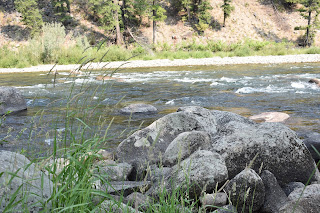While we were in Gorongosa, we had the opportunity to take a
canoe trip down the Pungue River. We
jumped at the chance. Early one
afternoon my husband and I plus two women from our group were driven to the
river. Bob and I crawled into our canoe
and Teresa and Paula crawled into the other one. One guide sat in the back of each canoe. We were all wearing life jackets and
valuables were secured in wet bags. I
was ready with my camera which was protected under a poncho. Teresa and I, who were in the front, got a
paddle although we didn’t really have to do much because our guides were
perfectly capable of paddling alone. I
did use my paddle because I had a little experience canoeing.
Bob reached down to check the temperature of the water. “Don’t stick your fingers in the water!” said
our guide. We soon learned why. We hadn’t gone far before our guide pointed
out a large crocodile lying on top of the bank.
Just as we were passing, the crocodile suddenly lifted his head, turned
and began heading down the bank toward the water. He was looking directly at us! Where was he going?!? He hit the water and turned to his right,
away from us. Phew!
A minute later our guide declared that there was a crocodile
right under us. I was too far forward to
see it but Bob saw it. He said he could
have reached out and touched it. Soon we
were distracted by large birds flying directly over us. I managed to snap a few photos. They are called African skimmers. Their pointed wings and bright red bills were
striking. They were gone so quickly.
Our guide showed us breaks in the foliage and huge flattened
areas leading to the water. This is where
elephants leave the park and cross the river to the village on the other side
to raid their crops. As we floated further
down the river we observed an odd structure to our right. Our guide explained that it was a fish trap.
We began noticing many small, colorful birds. They filled some of the trees. These bee eaters live in holes in the river
bank. They were so lively and beautiful
to watch.
There were so many different types of trees and bushes along
the river but the strangest one was probably the sausage tree. Their huge fruits are a favorite with not
only humans, but baboons, bush pigs, elephants, hippos, bats, and more.
As we neared the end of our canoe trip, we passed another
crocodile. This one was much smaller and
was resting his head on a little island.
When our guides prepared to land our two canoes they
realized that they couldn’t go in where they usually went in because the water
was higher with all the rain we had been getting. Suddenly, I needed to paddle and fast. We were turning against the current and got
caught on a stump sticking out of the water.
I pushed with my paddle with all my might to move away from this
obstacle. The canoe was wobbling and I
was afraid that we might turn over. I
was worried about my new camera—I didn’t even think about the crocodiles. . .
until later. Finally, we were safely on
dry land and we climbed out of our canoes.
The sun was setting so there was a lovely table waiting for us –
sundowner time. As we downed our gin and
tonic, we watched our guides drag the canoes across the sand. Carol and Gabby, who had come to pick us up
and had prepared the table for us, finally took the canoes from the guys and
dragged them up to the vehicles. We
joked about the women doing the hard part.
It took strength to get those canoes up that embankment.



The sun had set and we drove back through an increasingly
dark jungle. It looked like we were
going through a tunnel. The entire time
our guides were watching for animals. We
were able to glimpse a spotted eagle owl and a mongoose. We heard elephants crashing through the trees—and
a couple people actually saw them. Under
the cover of darkness they were heading to the Pungue River. And we knew where they would go from there.














































